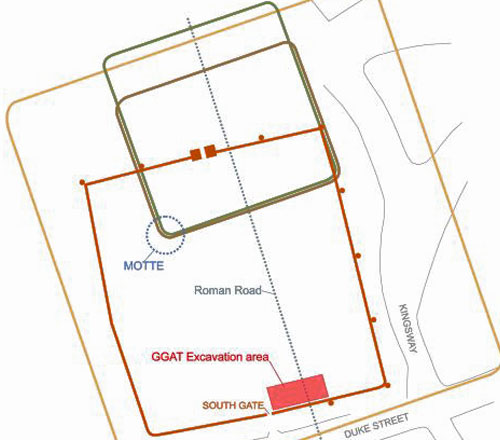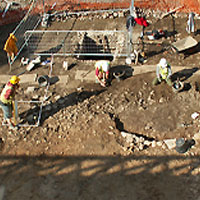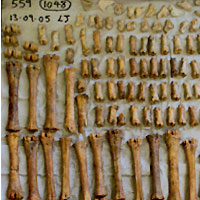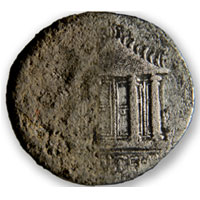Past Excavations
Excavations conducted at Cardiff Castle between 1974 and 1981 by Dr Peter Webster (Cardiff University) have provided evidence for a sequence of four overlapping Roman forts. A large Neronian fort first occupied the site in the mid 1st century AD, extending beyond the limits of the current castle. It has been suggested that on the basis of the presumed principia in the northeast quarter of the castle, the fort covered an area of 12ha. The second fort (occupied in the late 1st century AD) covered an area roughly one-fifth of this size, but retaining elements of its north-south axial road and northern defensive line. The third fort (c. early 3rd century) was aligned on very similar lines, although located slightly to the south. The fourth Roman fort (c. mid 3rd century) was stone built with its lines dictating the alignment of the medieval castle.
Despite suggestions of a Roman origin for the castle as early as 1862, it was not until 1889 that a Roman wall was identified within an earthen bank on the east side of the castle perimeter. Between 1889 and 1923, intermittent excavations eventually revealed the entire circuit of the Roman walls. Indeed, five separate observations noted that the medieval curtain wall followed and incorporated Roman fabric at lower levels. A limited excavation by Dr Michael Jarrett (Cardiff University) in 1960 to the west of the south gate indicated that the Roman ditch had been completely removed by the larger medieval ditch.
A series of unpublished excavations were conducted in the late 19th century for the third Marques of Bute, details are scarce although the piles of a timber bridge were recorded in the motte ditch and fragments of a drawbridge were recovered from the adjacent Middle Gate. Excavations in the Outer Ward by Dr Peter Webster revealed late medieval buildings, with the most notable being the Shire Hall. Evidence of occupation dating to the beginning of the medieval period was limited to rubbish pits, suggesting that any buildings dating to this period were timber constructions.
When John, Lord Mountstuart, acquired the castle in 1776 he set about a series of extensive renovations, including the removal of the Shire Hall and the filling of the moat around the motte. Under his direction, Henry Holland was engaged to reconstruct the Western Apartments, adding a new southern wing to balance a restored wing to the north. However, work was abandoned in 1794 and the Apartments were not completed until 1818 when Sir Robert Smirke was employed by John, the second marques of Bute (1814-1848). The third marques of Bute, also John (1848-1900), collaborated with William Burges, which resulted in the raising of the Clock Tower, the redesign of the Western Apartments and restoration of the Roman walls. The fourth marques (1900-1947) rebuilt the South Gateway and added a small square turret to the Ladies Walk.
Menu
Past excavations Previous archaeological investigations in the area have indicated that four Roman forts, all of slightly differing size and shape, were located on the site before Cardiff Castle was built in the medieval period. Learn More
The 2005-2006 excavations With the building of a new interpretation centre at Cardiff Castle an opportunity for a full archaeological investigation of the proposed area was undertaken. The excavations provided us with fascinating new insights into the history of one of Cardiff’s most prominent landmarks. Learn More
Post-excavation and reporting works The post-excavation assessment works were carried in two stages. These resulted in a completed site summary of the excavated remains by phase and included assessments by specialists of the various categories of artefact and environmental remains. Learn More
Artefact conservation A total of 890 small finds and context designations representing 2000+ individual objects were examined and/or treated between November 2018 and May 2019. Learn more
About the project
Cardiff Castle is one of the most significant heritage assets in the Principality. Sited in the centre of the capital of Wales, it is in the care of Cardiff City Council. The Castle has a long history with physical evidence of remains from the Roman, medieval and early post-medieval remains accessible to visitors and the remarkable neo-gothic restoration.
Please see here to find out more about us, our activities and our forward strategy







